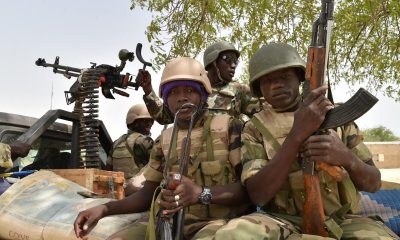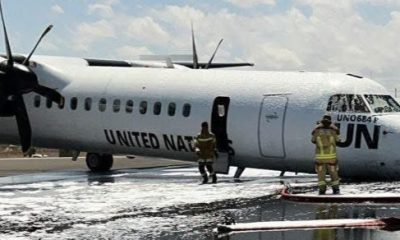Terrorism
Puntland Deputy Speaker Survives ISIS Attack Amid Rising Threat

Intense assault highlights growing danger of IS-Somalia as Puntland intensifies counterterrorism efforts.
Puntland Deputy Speaker Mohamed Shire Baari narrowly escaped a brazen attack by Islamic State militants in the Dharjaale area of Somalia’s Bari region. The ambush, involving a suicide bomber and heavily armed fighters, underscores the escalating threat posed by IS-Somalia as it expands its foothold in the region.
The attack unfolded Tuesday morning when a suicide explosion targeted Puntland forces led by Baari. This initial blast was followed by intense combat as militants engaged in close-quarters battle. Baari, in Dharjaale to organize anti-ISIS operations, emerged unscathed, but the attack inflicted casualties among Puntland forces. The exact toll remains unconfirmed.
Preliminary findings indicate that foreign fighters participated in the assault, with one detonating a suicide vest while others launched a coordinated attack on Puntland forces. However, the militants were ultimately neutralized, demonstrating Puntland’s capacity to respond swiftly to such threats.
This attack highlights the growing menace of IS-Somalia, whose estimated 600-700 fighters have been bolstered by an influx of foreign operatives, as noted in a November 2024 United Nations report. The group has capitalized on Puntland’s rugged Alimiskat mountains, establishing the area as a stronghold and staging ground for operations.
Puntland state leaders have ramped up their counterterrorism campaign, with large-scale offensives targeting IS-Somalia’s bases. These efforts are critical to dismantling the group’s infrastructure, but the latest attack shows the enduring challenges posed by insurgents capable of sophisticated and coordinated strikes.
The resurgence of ISIS in Somalia not only threatens Puntland but also destabilizes the broader region. The group’s tactics—ranging from suicide bombings to guerrilla warfare—have sown fear and disrupted governance in Somalia’s northern territories. The attack on Baari serves as a stark reminder of the urgent need for sustained military action and international support to contain the group’s expansion.
As Puntland intensifies its counterterrorism operations, the success of these efforts will hinge on robust intelligence gathering, regional cooperation, and targeted offensives to dismantle IS-Somalia’s networks. The stakes are high, with the outcome of this campaign likely to shape the region’s security landscape in the years ahead.
Editor's Pick
Captive German Nurse Makes Desperate Plea After 7-Year Somalia Ordeal

Sonja Nientiet urges swift German government intervention, warning her health is critically deteriorating after seven years in captivity.
In a new video released after seven agonizing years of captivity in Somalia, German nurse Sonja Nientiet has urgently pleaded for the German government to intensify efforts to secure her immediate release. Nientiet, who was abducted in Mogadishu in 2018 while working for the International Committee of the Red Cross (ICRC), expressed dire concerns about her rapidly deteriorating health.
“My health is deteriorating,” Nientiet says emotionally in the video, posted by an individual named Liibaan Osman. She urgently warns that “every day that passes makes the situation more critical,” emphasizing that her prolonged captivity could soon claim her life.
Nientiet was kidnapped on May 2, 2018, after armed assailants—allegedly with inside help from a disgruntled security guard—stormed the ICRC office in Mogadishu. Despite intensive German intelligence efforts to track down her location and captors, who have demanded millions of dollars in ransom, the nurse remains captive and vulnerable.
The release of this disturbing footage has intensified pressure on the German government to secure Nientiet’s freedom. Yet, authorities have publicly maintained their longstanding policy of silence on hostage negotiations, declining direct comment.
Before her abduction, Nientiet had provided humanitarian assistance in Syria and the Democratic Republic of Congo, highlighting her commitment to aid in conflict zones. The ICRC expressed renewed urgency following the video, stating deep concern for her safety and health.
With her desperate plea now public, the stakes for Germany have dramatically increased, shifting the crisis into an urgent test of diplomatic resolve—one where each passing day could tragically mark the difference between life and death.
Terrorism
U.S. Airstrikes Hit ISIS in Al Miskaad Mountains — But Can Air Power Break a Grounded Insurgency?

Late Monday night, U.S. airpower once again entered the skies over Somalia’s rugged north. This time, it struck deep into the Miiraale Valley within the Al Miskaad mountain range, targeting entrenched ISIS militants in one of the most formidable insurgent hideouts in the Horn of Africa.
The strike, confirmed by Puntland security officials and U.S. defense sources, is the latest in a series of joint operations aimed at crippling the Islamic State’s growing footprint in the region. But observers warn: while drones may kill fighters, airstrikes alone won’t dislodge ideology or infrastructure.
Why Al Miskaad Matters
The Al Miskaad mountains — isolated, harsh, and largely ungoverned — offer ISIS militants a natural fortress. Since splintering from Al-Shabaab, ISIS has carved out strongholds in Somalia’s northeast, recruiting local clans and importing foreign fighters who seek safe haven from pressure elsewhere.
Launched jointly by Puntland security forces and supported by international partners, including the United States, Operation “Lightning” has reportedly killed dozens of ISIS fighters over the past few months. The most recent U.S. strike, officials claim, targeted key logistics sites in Miiraale Valley.
Puntland’s government says it is making gains — but ISIS’s ability to launch attacks, including December’s deadly assault on security forces, suggests otherwise. Fighters, including foreign jihadists, continue to infiltrate the region, bringing cash, ideology, and combat experience.
What Comes Next?
Puntland forces say they remain committed to rooting out ISIS from the region. But the rugged terrain, lack of sustained local governance, and the difficulty of intelligence-gathering in such a hostile environment mean the conflict is far from over.
For now, the U.S. strike may have decimated a camp or killed key operatives. But the deeper question remains: can Puntland and its allies keep ISIS from regrouping, or will the Al Miskaad mountains continue to echo with gunfire?
Terrorism
Al-Shabaab Defector Testifies: Buuhoodle Has Become a Training Hub for Militants

Explosive testimony emerged from the Puntland Armed Forces Court on Monday, as one of 10 defendants on trial for alleged ties to terror groups Al-Shabaab and ISIS claimed that Buuhoodle town is a known recruitment and training center for Al-Shabaab.
The unnamed defendant, who told the court he defected from Al-Shabaab, stated that residents of Buuhoodle were trained in Jilib, the group’s longtime headquarters in southern Somalia. He further claimed he had been instructed to establish a training camp in Buuhoodle but refused, saying, “That is what made me turn away from Al-Shabaab.”
“Most of the people living in Buuhoodle are Al-Shabaab. Many of those who trained with me have already been arrested,” the man told the court.
According to the court proceedings, the man had initially fled to Hargeisa but claimed he was harassed, leading him to travel to Jilib for training. After defecting, he surrendered to Ethiopia’s Liyuu Police, who reportedly told him they couldn’t help and advised him to seek refuge in Puntland instead. He insisted he has committed no crimes, but said he feared for his life after rejecting Al-Shabaab’s ideology.
The court in Bosaso is expected to issue verdicts soon against the 10 men on trial, which include two foreign nationals.
Defendants:
- Nuur Mohamed Macalin, 30
- Mutahar Xamud Qayib, 24 (foreigner)
- Salaad Caseyr Muse, 62
- Mushir Mohamed Said, 38 (foreigner)
- Ibrahim Yuuya Ali, 35
- Abdilaahi Ali Ayuu, 25
- Abdilaahi Ahmed Yusuf, 25
- Mohamed Macalin Adan, 25
- Hasan Yusuf Macalin Isaaq, 27
- Amxmed Mohamed Abdi, 40
Background:
Al-Shabaab, a U.S.-designated terrorist organization, has long used Jilib as its main stronghold and training base. The group has been responsible for hundreds of deadly attacks across Somalia, Puntland, and even neighboring Kenya and Ethiopia. The allegation that Buuhoodle, located near the Somaliland-Ethiopia border, is becoming a training hub raises major regional security concerns.
This case may further strain inter-regional relations as Puntland courts make bold assertions implicating residents of Somaliland territory in militant activity. The outcome of the trial — and any potential reaction from local communities or political entities — could have significant national security implications.
Stay with WARYATV for exclusive coverage.
Terrorism
Turkey’s High-Tech Aid to Somalia: Akinci Drones Set to Transform Anti-Terror Strategy

Turkey escalates its military support for Somalia with advanced unmanned aerial vehicles, aiming to turn the tide against Al-Shabaab.
Turkey has stepped up its military aid to Somalia by deploying advanced Bayraktar Akinci drones, significantly enhancing Somalia’s capabilities to combat the persistent threat posed by Al-Shabaab. This strategic move not only amplifies the Somali National Army’s (SNA) operational effectiveness with high-endurance, precision-targeting technology but also marks a pivotal shift in the regional power dynamics.
The introduction of the Akinci drones, equipped with superior surveillance systems and an impressive payload capacity, promises a new era in precision airstrikes for Somalia. These drones can carry a diverse arsenal, from SOM cruise missiles to MK-82 bombs, enabling detailed and discrete operations against militant hideouts without significant collateral damage.
This deployment underlines Turkey’s robust commitment to Somalia’s security architecture, extending beyond mere military hardware to encompass training and infrastructural support. By enhancing the SNA’s tactical capabilities, Turkey is not just countering the immediate threats but also contributing to a long-term stability strategy in the Horn of Africa.
Analysts view this development as a game-changer that could deter Al-Shabaab’s operations and reduce their territorial control, potentially leading to a more secure and stable Somalia.
Terrorism
Former ISIS Leader Dies in Puntland Prison: Details Unconfirmed

Ex-ISIS commander Abdirahman Shirwac Lahore’s mysterious death in Puntland custody raises questions ahead of major anti-ISIS operations.”
Former senior ISIS figure Abdirahman Shirwac Lahore has died under unclear circumstances in a Bosaso prison, as Puntland’s security forces brace for a new offensive against the terror group’s remnants and affiliates.
Lahore, 60, had been detained since early February after defecting from ISIS and surrendering. Despite facing a death sentence for his alleged role in numerous terror acts in Bosaso, the cause of his death remains undisclosed, fueling speculation and concern ahead of planned security crackdowns.
Puntland Airstrikes Devastate ISIS Strongholds, Killing Over 30 Fighters
Puntland Claims it Uncovered ISIS Treatment Sites, Business Links in Somaliland
U.S. and UAE Joint Operation Kills 16 ISIS Militants in Puntland Stronghold
Telegram Shuts Down Key ISIS Propaganda Channel Amid Puntland Conflict
Puntland Forces Close in on ISIS Stronghold, Final Battle Nears
Terrorism
Somali Journalist Killed in Al-Shabaab Bombing Aimed at Presidential Convoy

Somali journalist Mohamed Abukar Dabaashe becomes the first press fatality of 2025 in a deadly attack targeting President Hassan Sheikh Mohamud’s convoy in Mogadishu.
In a grim morning in Mogadishu, chaos ensued when a bomb exploded at El-Gab Junction targeting the convoy of Somali President Hassan Sheikh Mohamud. While the President emerged unscathed, the attack claimed the life of Mohamed Abukar Dabaashe, a journalist working with Radio Risaala, marking him as the first journalist casualty in Somalia for the year 2025.
The attack occurred in close proximity to Villa Somalia, the official residence of the President, underscoring the daring nature of Al-Shabaab’s insurgency. Dabaashe, a respected figure in the Somali media landscape, was fatally caught in the blast while a nearby building collapsed in the aftermath. This tragic incident underscores the perilous conditions under which journalists operate within the country.
Al-Shabaab promptly claimed responsibility for the attack, stating their intent to kill the president. This bold assertion marks a significant escalation in the group’s tactics, considering it the first direct attempt on President Mohamud’s life since an incident in 2014 during his earlier tenure.
The Somali Journalists Syndicate (SJS) immediately condemned the attack, mourning the loss of Dabaashe as a major blow to the press community. The loss was further compounded by the death of another journalist, Ayuub Wardheere, who perished in the same attack. The Somali Women Journalists Organization (SWJO) expressed its heartache over the incident, highlighting the ongoing risks faced by media professionals in Somalia.
The condemnation reached political echelons with former President Sharif Sheikh Ahmed denouncing the act as cowardly and calling for national unity against such terrorism. He emphasized the non-combatant status of the fasting victims, including Dabaashe, during this holy month, underscoring the barbaric nature of the attack.
Following the incident, President Mohamud was seen in Middle Shabelle overseeing a military campaign against Al-Shabaab, signaling a strong governmental response to the insurgent threat. In reaction to the attack, Somali security forces initiated widespread counterterrorism operations in Mogadishu, with expectations of heightened security measures to safeguard the capital against future threats.
This attack not only represents a tragic loss for the media community but also illustrates the volatile security situation in Somalia, where journalists remain vulnerable to the broader conflict affecting the nation. The death of Dabaashe serves as a somber reminder of the challenges and dangers journalists face while covering stories in one of the world’s most dangerous regions for the press.
Somalia
Al-Shabaab Targets Somali President’s Convoy Four Dead

Mogadishu on the Brink: Al-Shabaab’s Bold Strike Mirrors Taliban’s Ascendancy.

Al-Shabaab’s audacious attack on the Somali President’s convoy highlights the looming threat of a takeover akin to the Taliban’s rise in Afghanistan, signaling potential collapse of central authority in Somalia.
In a scene distressingly reminiscent of the Taliban’s takeover in Afghanistan, Al-Shabaab’s recent attack on President Hassan Sheikh Mohamud’s convoy in Mogadishu starkly highlights the insurgent group’s undiminished potency and ominous intent in Somalia. This bold assault not only targeted the nation’s leader but also exposed the precariousness of the Somali government’s grip on power, confined to an ever-shrinking stronghold within Mogadishu’s Halane base—often referred to as the most secure zone in the capital.

The incident starkly illustrates how Al-Shabaab, despite facing extensive counterterrorism measures, continues to infiltrate high-security zones, suggesting possible collusion with insiders and raising fears that the capital could fall. This attack serves as a grim portent of Al-Shabaab’s capabilities and intentions, mirroring the strategic encroachments that preceded the Taliban’s swift resurgence in Afghanistan.
The global community, having invested immense resources in Somalia for over three decades, watches with growing dismay as the situation deteriorates. The persistent instability and the seeming futility of continued financial aid, which some critics compare to pouring resources into a bottomless pit, has led to international exasperation. Moreover, there is an increasing perception among experts that the Somali government and Al-Shabaab might be two sides of the same coin, with accusations of corruption and collusion weakening the official stance against terrorism.

Despite immediate international reactions condemning the attack—highlighted by a strong statement from the UK—the broader implications are troubling. The Somali government’s failure to secure even the most critical areas of Mogadishu from such attacks not only undermines local confidence in their leadership but also signals a potentially catastrophic lapse in the nation’s security architecture, akin to the pre-collapse conditions observed in Afghanistan.
As President Mohamud proceeds to the frontlines, ostensibly to rally the troops and strategize counter-offensives, the shadow of Al-Shabaab’s threat looms large, suggesting that without significant and effective international support and a radical overhaul of internal security protocols, Somalia might well be on the path to becoming the next Afghanistan in terms of militant takeover and governmental collapse.
Terrorism
Somalia: U.S. Ramps Up Anti-Terror Efforts in Africa

As the U.S. intensifies airstrikes targeting ISIS and al-Shabaab in Somalia, the broader implications signal a strategic shift in America’s global counterterrorism approach.
February saw a significant uptick in U.S. military activities in Somalia, indicating a sharp strategic shift in America’s counterterrorism efforts. This ramp-up involves multiple airstrikes, particularly targeting high-value terrorists, which underscore a renewed focus on Africa as a central battleground against global terrorism.
Despite previous administrations’ focus on reducing U.S. military footprints abroad, current actions in Somalia suggest a different trajectory under the new administration. This shift is partly in response to the growing terrorist threats that continue to emerge from Africa, notably from groups like ISIS and al-Shabaab.
The recent operations by the U.S. Africa Command (AFRICOM) successfully eliminated key figures such as Ahmed Maeleninine, a prominent ISIS leader and recruiter. These strikes are not isolated incidents but part of a broader campaign to dismantle terror networks that pose direct threats to regional stability and U.S. national security.
The continued presence and expansion of terrorist groups in Somalia have drawn a direct response from the U.S., highlighting the strategic importance of Africa in the global fight against terrorism. The operations extend beyond mere military action, reflecting a comprehensive approach that includes intelligence sharing, local military training, and counterterrorism financing efforts.
Africa’s growing role as a front line in the war on terror presents both opportunities and challenges for U.S. policy. With over 3,400 terrorist attacks recorded in the continent in 2024 alone, the U.S. is poised to increase its military and strategic investments significantly. This involves not only combating immediate threats but also addressing the underlying socio-political factors that contribute to regional instability.
The U.S. is likely to continue its robust military engagements in Africa, particularly in Somalia, as part of its broader strategy to counteract the spread of terrorism. The focus will likely be on enhancing the capabilities of local forces while maintaining a sustainable U.S. military presence to support these efforts.
This strategic pivot reflects a clear recognition of the evolving nature of global terror threats and the critical role Africa plays in the international security landscape. As the situation develops, the effectiveness of these efforts will be closely monitored to ensure they achieve their intended goals of enhancing security and stability in the region.
-

 Analysis3 weeks ago
Analysis3 weeks agoSaudi Arabia’s Billion-Dollar Bid for Eritrea’s Assab Port
-

 ASSESSMENTS3 days ago
ASSESSMENTS3 days agoOperation Geel Exposes the Truth: International Community’s Reluctance to Embrace Somaliland as a Strategic Ally
-

 Somaliland2 months ago
Somaliland2 months agoSomaliland and UAE Elevate Ties to Comprehensive Strategic Partnership
-

 Africa12 months ago
Africa12 months agoHow Somaliland Could Lead the Global Camel Milk Industry
-

 Analysis12 months ago
Analysis12 months agoIran escalates conflict, attacking Israel; US forces help Israel to intercept Iranian projectiles
-

 Top stories10 months ago
Top stories10 months agoGunmen Kill 11 in Southeastern Nigeria Attack, Army Reports
-

 Analysis12 months ago
Analysis12 months agoIsrael and Iran on Edge: Tensions Escalate Amidst Rising Threats
-

 TECH10 months ago
TECH10 months agoZimbabwe Approves Licensing of Musk’s Starlink Internet Service



























